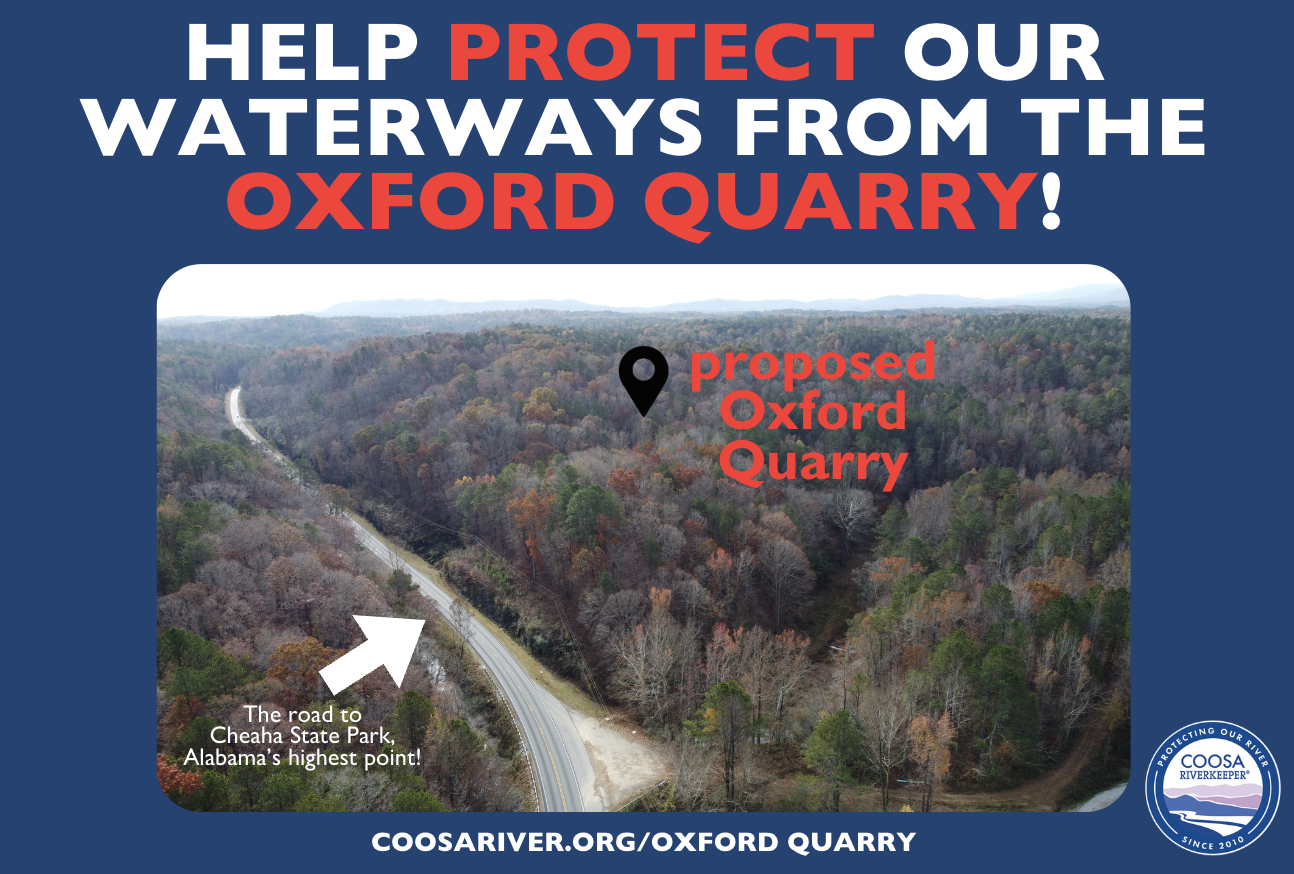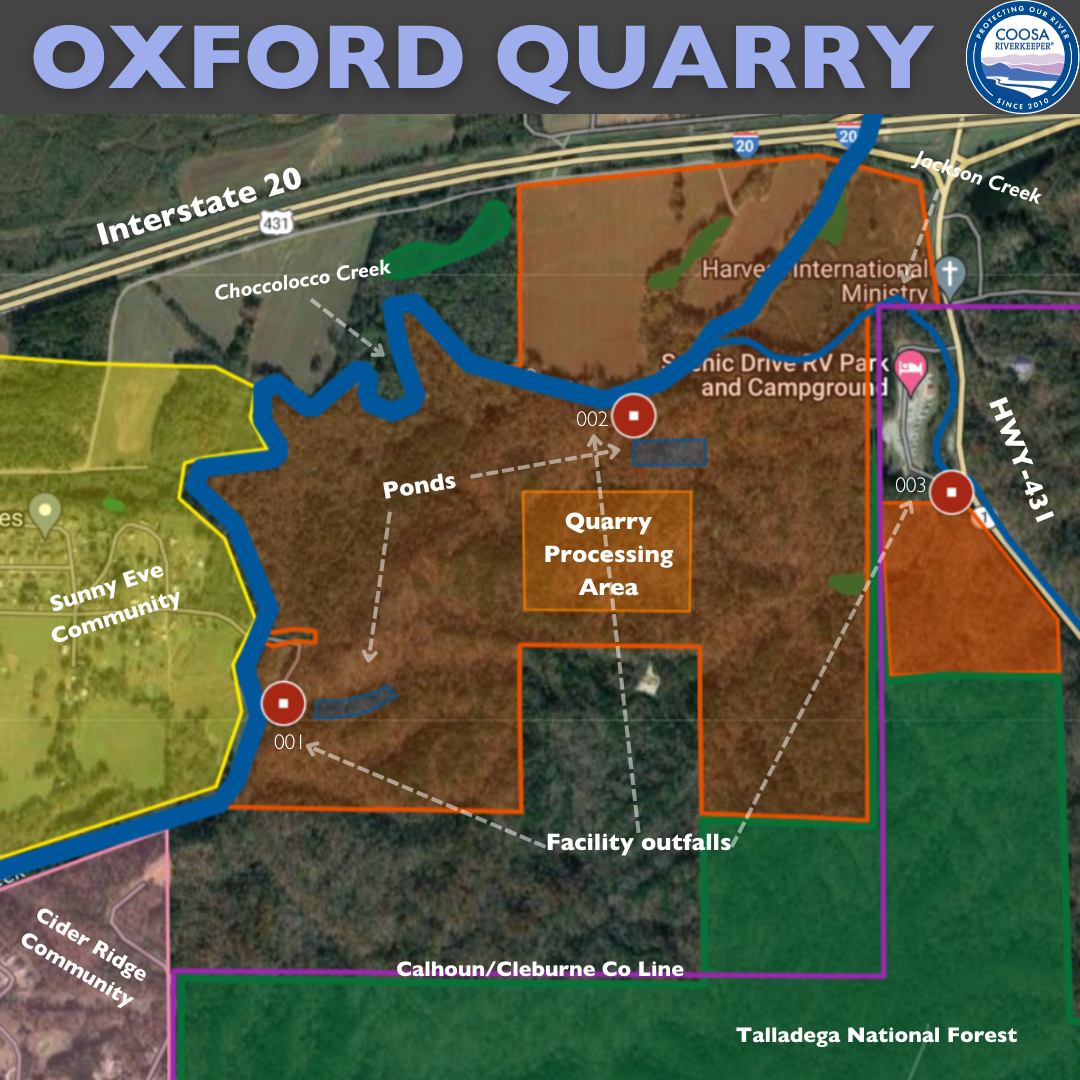Coosa Riverkeeper is concerned about the proposed 431 Quarry near Oxford. This nearly 350 acre quarry has the potential to impact water quality, local wells, and quality of life for surrounding communities. Please read below and make your voice heard at the upcoming public hearing and/or submit comments!

Please note that if you commented on the website NoOxfordQuarry.com your comments DID NOT go to the Alabama Department of Environmental Management’s website.
Here’s the Skinny on the Permits:
Pillar Materials, LLC, has applied for the issuance of Air Permits, Air Permit Numbers 305-0008-X001 and X002 that would authorize the construction and operation of limestone crushing, screening, and conveying circuits. Emissions would be minimized by wet suppression. The Department has determined that the equipment/operations proposed by the company should be able to meet State and federal air pollution control requirements.
Pillar Materials, LLC, has also applied for issuance of a National Pollutant Discharge Elimination System (NPDES) Permit, NPDES Permit Number AL0084482, that limit discharges from a crushed stone quarry, wet preparation, transportation and storage, and associated areas discharging to Choccolocco Creek and Jackson Creek, classified as Public Water Supply and Fish and Wildlife, in the Coosa River Basin.
Public Hearing & Comment Period
Day(s)
:
Hour(s)
:
Minute(s)
:
Second(s)
Public Hearing Date & Information
Alabama Department of Environmental Management (ADEM) is extending the Public Comment Period and will hold a Public Hearing on Tuesday, January 23, 2024, at 6:00 P.M., at the Oxford Civic Center located at 401 McCullars Lane, Oxford, AL 36203, concerning the proposed issuance of Air Permits and proposed issuance of a National Pollutant Discharge Elimination System (NPDES) Permit to Pillar Materials, LLC, for the proposed limestone quarry to be located at 226 Cheaha State Park Drive, Anniston, AL 36207.

TAKE ACTION!

Dive into the Concerns
Water Quality Concerns
- Jackson Creek is a tier II stream which was determined by ADEM to have a water quality level substantial enough to support propagation of fish, shellfish, and wildlife and recreation in and on the water. Based on this determination, ADEM states that the discharge into this stream is necessary for economic development of the area, and discharge into this creek shouldn’t have adverse impact on it. Based on the discharge volume from Outfall 003 there is no way that the volume, velocity, and pollutants from this quarry will not negatively impact this small stream.
- Choccolocco Creek is a tier I stream listed under the 303(d) list of impaired waters. Choccolocco Creek has a use-classification of Public Water Supply (PWS) and Fish and Wildlife (F&W). The designation of a use does not imply a license to degrade water quality. Since this creek has multiple uses, the permit should honor the level of water quality necessary to support the most sensitive designated use.
- Choccolocco Creek has a plethora of impairment statuses including pathogens, PCBs, and Mercury, however, this permit only refers to the impairment status of pathogens given its location.
- Part of the quarry property will be inside the boundary of a flood zone. This raises concerns in regards to severe weather events and how the change in water quantity could negatively impact the stream or surrounding areas due to flooding.
- Total discharge from the facility is 528,000 gallons per day into Choccolocco Creek and Jackson Creek.
- Outfall 001 will discharge into Choccolocco Creek (Tier I creek) at 33.60582, -85.73965 with an expected flow rate of 84,000 gallons per day.
- Outfall 002 will also discharge into Choccolocco Creek (Tier I creek) at 33.61173, -85.73102 with an expected flow rate of 130,000 gallon per day.
- Outfall 003 will discharge into Jackson Creek (Tier II creek) at 33.61016, -85.72319 with an expected flow rate of 314,000 gallons per day.
- Although the proposed quarry is preparing to have larger retention ponds than the permit requires, our organization is concerned that excess sediment entering Choccolocco Creek could serve as a vehicle for pathogens to make their way downstream. Please note that E.coli can survive in up to 9.0 pH water.
- This is an important distinction because the high volume of discharge of water (314,000 gpd) will have a higher average of Total Suspended Solids, Total Manganese, and Total Iron into a smaller receiving waterway.
Well Concerns
- Water Table Disturbance: Quarrying activities involve digging deep into the ground. This interference can alter the flow and levels of underground water, which may directly impact nearby wells by reducing their water levels or even causing them to dry up.
- Contamination Risk: Quarrying involves the use of heavy machinery, explosives, and chemicals for blasting and processing limestone. These activities can release sediment, pollutants, and chemicals into the groundwater, potentially contaminating nearby well water. Chemicals like ammonium nitrate and fuel oil used in explosives, or chemicals used in the processing of limestone, can leach into the ground.
- Sedimentation: Quarrying can lead to increased sedimentation in nearby water sources. Sediment runoff from the quarry site can affect the clarity and quality of water in streams, rivers, or other bodies of water connected to the local groundwater system, potentially impacting the wells drawing from these sources.
- Cracks and Fractures: Quarrying involves the creation of deep cuts and removal of large amounts of rock. This process can cause fractures and fissures in the bedrock, potentially altering the flow and direction of groundwater, affecting nearby wells by changing their water quality or quantity.
Traffic & Public Safety Concerns
- Air Quality: Increased truck traffic can contribute to air pollution through emissions from diesel engines. This can affect local air quality, potentially leading to health issues for residents, especially those living close to the roads with heavy traffic.
- Noise Pollution: Trucks often generate considerable noise, particularly when navigating residential areas or smaller roads. The constant rumbling of trucks passing through can disrupt the peace and quiet of neighborhoods.
- Safety Concerns: More trucks on local roads can pose safety risks, especially in areas with pedestrians, cyclists, or schools. The larger vehicles and increased traffic volume might heighten the risk of accidents or collisions.
Threatened and Endangered Species
- It is important to consider the summer (21°C / 69.8°F) and winter (19°C / 66.2°F) discharge temperatures could be variable based on flows and should consider impact to local aquatic wildlife. Fluctuating water temperatures can have significant impacts on freshwater aquatic species, influencing their physiology, behavior, and overall well-being. Warm water holds less dissolved oxygen, however, it generally increases metabolic activity. Inconsistent temperatures can disrupt the balance between an organism’s metabolic rate and available oxygen levels. In warm months, fluctuation can exacerbate oxygen depletion, potentially leading to low oxygen levels, or hypoxia. Temperature fluctuations can influence the susceptibility of aquatic species to diseases.
- Stress caused by rapid temperature changes may weaken the immune system, making individuals more vulnerable to infections. Additionally, some pathogens and parasites may thrive in specific temperature ranges, and fluctuations can affect their prevalence.
- Fluctuating temperatures can also lead to changes in habitat conditions. For example, temperature changes can affect the growth of aquatic plants and algae, which can impact the availability of shelter and food for aquatic life. Habitat alterations can have cascading effects on the entire ecosystem, especially on an impaired creek like Choccolocco Creek which has many vulnerable populations of species.
- The U.S. Fish & Wildlife IPaC system generates a list of species and other resources such as critical habitat under USFWS jurisdiction that are known or expected to be on or near a project area referenced. It also includes species that may occur outside of the project referenced, that could be directly or indirectly affected by activities in the project area. While the extensive list includes mammals, birds, reptiles, plants, & clams, our immediate concern is with the Blue Shiner (Cyprinella caerulea). This species is federally listed as “Threatened.”
- Blue Shiners are native to the southeastern United States, and known to currently be distributed within just four watersheds, one of which is Choccolocco Creek. This species has been considered extirpated from the Cahaba River watershed since 1971, likely due to habitat destruction & alteration, and changes in water quality. The Blue Shiner is sensitive to changes in water quality and habitat disturbance. The presence of aquatic vegetation and clean water is crucial for their survival. Based on limited, open-sourced data, Blue Shiner populations have been observed in the Choccolocco Creek watershed in 2022. Many of the species that are threatened by the impacts of a quarry are unique and distinct species that contribute to overall biodiversity and contribute to the cultural and recreational value of natural environments.
Noise Pollution
- Machinery and Equipment: Quarry operations involve heavy machinery such as excavators, crushers, and trucks. These machines generate significant noise levels due to their operation, particularly during processes like drilling, blasting, and crushing limestone.
- Blasting: Explosives are often used in quarrying to break apart limestone. Blasting produces loud, impulsive noises that can travel long distances, causing disruptions to nearby residents and wildlife.
- Continuous Operation: Quarries often operate throughout the day and sometimes at night, leading to a constant background noise that can be disruptive to the surrounding area.
Light Pollution
- Artificial Lighting: Quarries may have extensive artificial lighting during nighttime operations for safety and productivity reasons. These bright lights can illuminate the area around the quarry, impacting the natural darkness of the night and potentially affecting the habits of nocturnal wildlife.
- Glare: The powerful lights used in quarries can create glare that extends beyond the quarry boundaries, affecting nearby residential areas and causing discomfort for residents and local wildlife.
Air Pollution
Dust created by quarries is considered respirable crystalline silica, a type of particulate matter. Studies have established a strong link between these particles and the following health effects:
-Silicosis
-Pulmonary disease
-Reduction in lung function
-Leukemia
-Atherosclerosis and heart disease
-Dysrhythmia
-Heart failure and cardiac arrest
-Stroke and cognitive disorders
-Fertility problems
-Miscarriage
-Premature birth
-Low birth weight
Those living near the quarry could be affected by cascading injurious events resulting from particulate matter carried by prevailing winds. The above health effects do not even take into account damage to the watershed.
